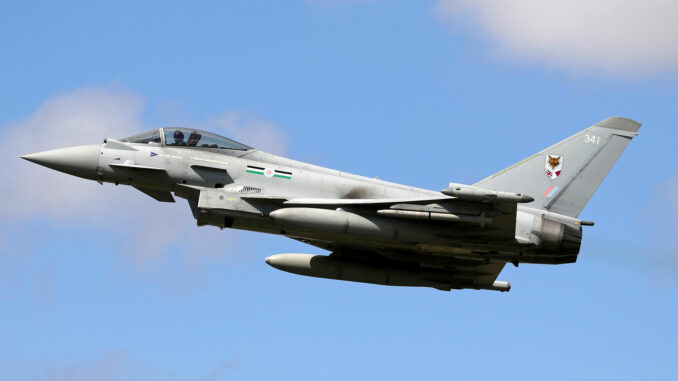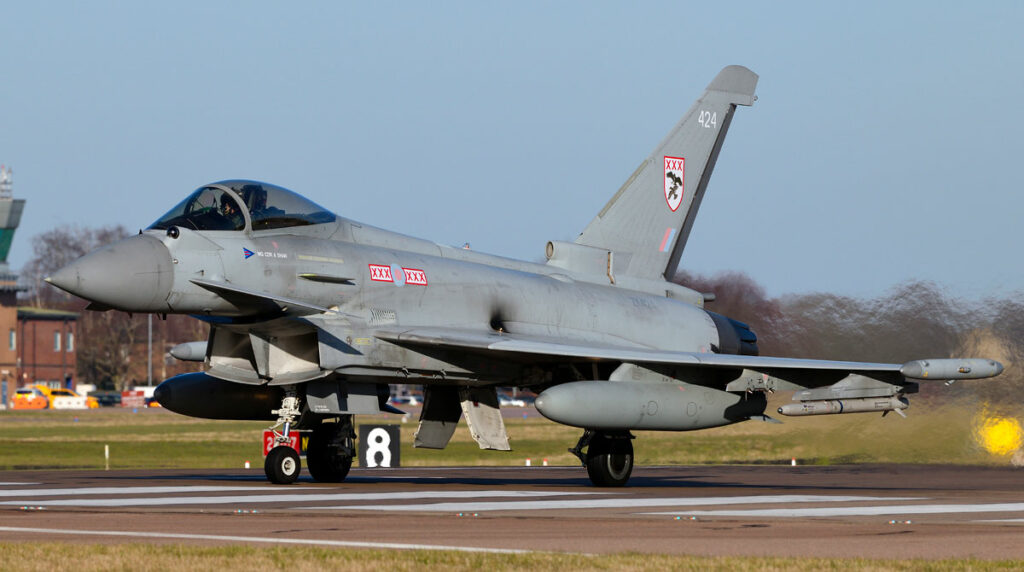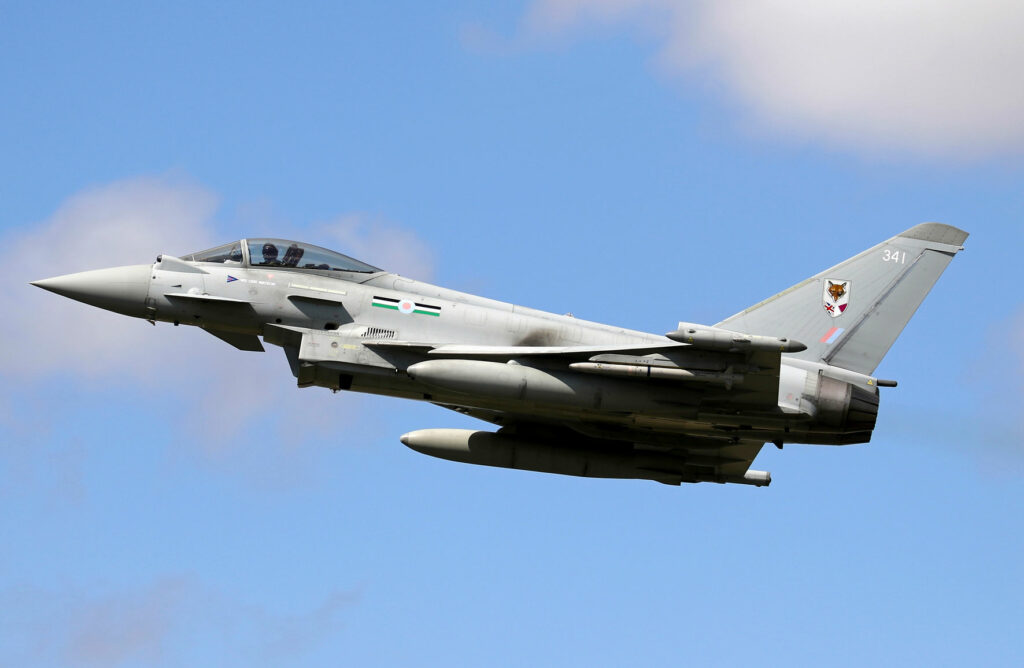
Technical and industrial analysis of the impact of the UK’s decision between the F-35 and Eurofighter, supported by figures and market data.
The UK is considering purchasing more F-35s instead of new Eurofighter Typhoons. This decision will have consequences for military capability, national industry, and diplomatic relations. BAE Systems, a key player in both programs, employs several thousand people in England to produce critical components for both aircraft. Opting overwhelmingly for the F-35 would increase dependence on the United States, weaken the European aerospace industry, and could affect employment in the United Kingdom. The F-35A offers superior stealth and electronic warfare capabilities but is less effective than the Eurofighter for certain specific missions such as rapid interception.
The industrial context of the F-35 versus Eurofighter choice
The UK’s decision to increase its orders for F-35s at the expense of the Eurofighter Typhoon will directly affect the national aviation industry. BAE Systems, the UK’s leading defense manufacturer, has a 15% stake in the production of the F-35, including the assembly of the rear fuselage, horizontal and vertical tailplanes, and critical electronic systems such as the electronic warfare suite and flight management computer.
BAE Systems employs 1,500 production specialists in Samlesbury for the F-35 program, out of a total of 2,300 employees dedicated to the project worldwide. These figures illustrate the importance of the program for local industrial employment.
In contrast, the United Kingdom has a 37% share of the Eurofighter program, which was historically planned as London was to be the main user. Today, this role has been taken over by Germany. Unite, an influential trade union, estimates that 6,500 jobs are directly linked to the Typhoon at BAE Systems and Rolls Royce, with an additional 14,000 jobs indirectly linked to the supply chain.
A concrete example: a phased shutdown of the Eurofighter program could directly threaten 10,250 jobs in northwestern England (half of the direct and indirect jobs), according to current industry estimates.
The economic consequences of such a decision would also include a loss of strategic technical expertise in the design and manufacture of European combat aircraft.

Military consequences of choosing between the F-35A and the Eurofighter Typhoon
Militarily, the technical characteristics of the two aircraft meet different needs. The F-35A is optimized for penetrating enemy airspace in the early hours of a conflict, thanks to its radar stealth and electronic warfare capabilities. It carries up to 8,160 kg of internal and external payload, with a range of 2,200 km without refueling.
By comparison, the Eurofighter Typhoon has a maximum speed of Mach 2 (approximately 2,450 km/h) compared to Mach 1.6 (1,975 km/h) for the F-35A. Its operational ceiling exceeds 16,800 meters, compared to 15,240 meters for the F-35A.
For quick reaction alert (QRA) missions, such as intercepting Russian aircraft approaching British airspace, rapid climb and supersonic speed are priorities. In this context, the Typhoon remains better suited than the F-35A.
Illustration: During NATO exercises in 2023, a Eurofighter Typhoon intercepted a Russian Tu-95 bomber in less than 15 minutes after takeoff, demonstrating its advantage in climb and speed.
Acquisition and operating costs: F-35A cheaper than F-35B
Economic costs are a key argument in the debate. The F-35A is estimated to be 15% cheaper to purchase than the F-35B. In 2024, the unit cost of the F-35A is estimated at $85 million compared to $100 million for the F-35B.
In terms of operating costs, the hourly cost of an F-35A is estimated at $26,000 compared to $28,200 for the F-35B, representing 8% savings on operating costs.
With a planned fleet of 74 aircraft, switching to the F-35A could represent a direct saving of $1.11 billion over 30 years (combined purchase and operating costs), according to an analysis based on figures from the UK Defense Procurement Office.
However, choosing the F-35A would restrict naval use, as it is unable to take off from British aircraft carriers without catapults and arresting wires, which would make a second aircraft carrier unnecessary.
Program security: risks surrounding the F-35
The F-35 program has been regularly exposed to data leakage risks. In particular, the Chinese-owned company Exception PCB supplied sensitive electronic cards for the F-35 before being removed from the program. In addition, according to reports from the Pentagon Cybersecurity Review, more than 30 terabytes of data relating to the F-35 and F-22 were stolen in cyberattacks attributed to Chinese entities.
This data is believed to have contributed to the development of the Chinese FC-31 and J-35 fighter jets, which incorporate several aerodynamic and electronic features observed on the F-35.
Direct consequence: the risk that adversaries will have radar signatures or effective countermeasures against the F-35 increases, which could limit its technological advantage in the long term.
Furthermore, the possibility that Turkey will rejoin the F-35 program remains a strategic threat. As the owner of Russian S-400 systems, Ankara poses a risk of exposing stealth data to Russian authorities, which would compromise the F-35’s superiority in contested areas such as Eastern Europe.

Diplomatic impacts: tensions with Europe and the United States
A massive choice in favor of the F-35 over the Eurofighter would have major diplomatic repercussions. Germany, through Airbus Defence and Space, is campaigning for increased support for the Typhoon to ensure European industrial sustainability until 2040.
The Global Combat Air Program (GCAP), led by the United Kingdom, Italy, and Japan, aims to bring a sixth-generation aircraft into service in 2035. This will require an orderly transition of industrial personnel and budgets.
Giving massive preference to the F-35 today could weaken Europe’s industrial capacity to maintain its aerospace skills until the GCAP arrives.
Projected consequence: a weakening of European technological sovereignty in new-generation combat aircraft and increased dependence on US technologies.
At the same time, a procurement policy that is too heavily weighted in favor of the Typhoon could irritate a future US administration, particularly if Donald Trump returns to the presidency. During his first term, he exerted direct pressure on European allies to favor US arms purchases.
Industrial outlook: rationalization before GCAP
The gradual withdrawal of Eurofighter Tranche 3 aircraft from 2035 is already planned for the British armed forces. Maintaining a mixed fleet of F-35As and future GCAPs seems logical from an operational standpoint.
Concrete example: in 2040, the UK plans to operate 60 F-35As and 80 GCAPs, with a limited number of surviving Eurofighters in reserve, according to projections by the UK Ministry of Defense.
A smooth industrial transition is imperative to avoid a loss of expertise in combat aircraft manufacturing, estimated at a critical threshold of five years of industrial inactivity, according to a study by the ADS Group (Association of the British Aerospace Industry).
Investment in optimizing current production lines would enable the transition to mass production of the GCAP to be prepared effectively without any technological disruption.
War Wings Daily is an independant magazine.